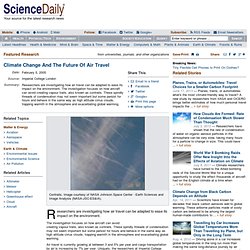

Airbus, a leading aircraft manufacturer. The future of Business Travel. With many companies still feeling the fallout from the recession, pressure to drive down travel costs and embrace new technology is now more relevant than ever.

But what does this mean for the future of business travel? Companies that are trading on a global scale are increasingly looking at their travel budgets with a view to reducing these costs and better managing the business travel that does take place. For all business travellers this means working smarter with the entire travel procurement process; and for enterprises overall, the adoption of new technology is becoming more vital than ever.
The future of air travel? The plane with 'clip on' cabins. Is this the future of air travel?

Swiss inventors unveil futuristic Clip Air project, which will allow passengers to board a train that converts into an airplane with attachable wings. 12, 2013 The model of an adjustable plane, with wings that can be attached to for instance train compartments, will be shown at the Paris Air Show next week, the Swiss inventors said Monday. The "Clip-Air" project is fresh off the drawing board and features a single flying wing that could be clipped onto for instance train "capsules" carrying passengers or cargo, the EPFL technical university in Lausanne said in a statement.
"More than a new type of flying device, its innovative concept could revolutionise the airports of the future," it said. What is the future of air travel? Everyone has had his or her fair share of airline related disasters. Cancelled flights, missed connections and lost bags, just to name a few. But even though the industry clearly has its flaws, the system as a whole is quite incredible. Now, extrapolate recent technological innovations out a bit and think about what air travel will be like 20 years from now.
Is this the future of air travel? The Future Of Air Travel. Sky Wi-Fi. Interactive Infographic: What Would A Hyperloop Nation Look Like? Explore a hypothetical North American Hyperloop network, where total travel time between cities by Hyperloop is represented by color. Click on a city to re-center the map at a different origin. Mouse over a destination city to compare calculated Hyperloop travel time with drive time and to see the additional travel time needed to reach nearby cities. Infographic by Michael Kelly. In August, Silicon Valley darling Elon Musk—CEO of SpaceX and Tesla Motors—unveiled his concept for the Hyperloop, a high-speed system of 28-person pods that would shoot through low-pressure tubes on air bearings.
Musk’s published proposal calls for the Hyperloop to link San Francisco and Los Angeles; pods would blast down the I-5 corridor at 760 mph, reducing the journey from five and a half hours by car to just 35 minutes. TOURISM INDUSTRY & AVIATION. Climate Change And The Future Of Air Travel. Researchers are investigating how air travel can be adapted to ease its impact on the environment.

The investigation focuses on how aircraft can avoid creating vapour trails, also known as contrails. These spindly threads of condensation may not seem important but some persist for hours and behave in the same way as high altitude cirrus clouds, trapping warmth in the atmosphere and exacerbating global warming. Air travel is currently growing at between 3 and 5% per year and cargo transportation by air is increasing by 7% per year. Uniquely, the researchers at Imperial College London are combining predictions from climate change models with air traffic simulations to predict contrail formation and identify ways of reducing it.
344na1rss.pdf. Air Travel’s Impact on Climate Change. Just one return flight from London to New York produces a greater carbon footprint than a whole year’s personal allowance needed to keep the climate safe.

Our carbon footprint is the estimated amount of carbon dioxide (CO2) given out as we travel, buy food, heat our homes and enjoy our usual lifestyles. The average personal footprint in Britain is 9.5t. To get down to a fair share of the world’s total; this must be cut by 87%, leaving 1.2t. On every flight to New York and back, each traveller emits about 1.2t of CO2. If we fly, air travel overshadows all our other impacts. We need to cut emissions by 90% by 2050, or better still, by 2030. The Tyndall Centre for Climate Change Research says we need to cut emissions by 90% by 2050 – they believe this can be done, provided that a programme of work is started in the next four years.
Kroo. Cntraveler. Just over a decade ago, ten large airlines offered frequent service around the country.

But after a series of failures and mergers, that number stands at five. Now American Airlines is set to merge with US Airways in a union that will not only make American the world's largest carrier but will leave only four carriers—American, Delta, Southwest, and United—controlling what some analysts estimate is nearly 85 percent of U.S. air traffic, leading to higher fares, fewer flights, and less choice for many fliers. (JetBlue and Alaska, by comparison, have just four and three percent, respectively, of the U.S. market.) "We are in the ninth inning of the game of consolidation" that began with airline deregulation in 1978, says David Berkowitz, an aviation industry consultant.